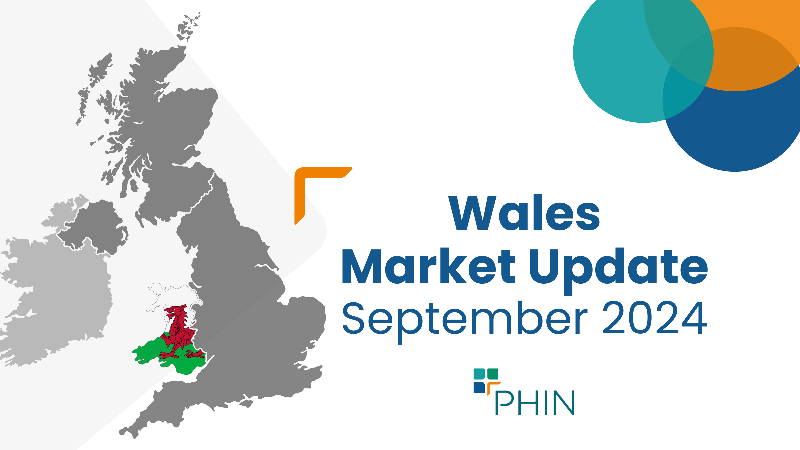In the latest of our quarterly updates, we use our unique, national dataset to look at the key trends in the independent healthcare sector up to, and including, Q1 2024. The data covers reported private healthcare in-patient/day-case market activity, insured cases, ‘self-pay’, along with national/regional and procedural breakdowns and demographic information. (Q1 = Jan – Mar; Q2 = Apr – Jun; Q3 = Jul – Sep; Q4 Oct – Dec)
Private healthcare sector market activity
In-patient/day-care admissions comparison Q1 2019 – Q1 2024
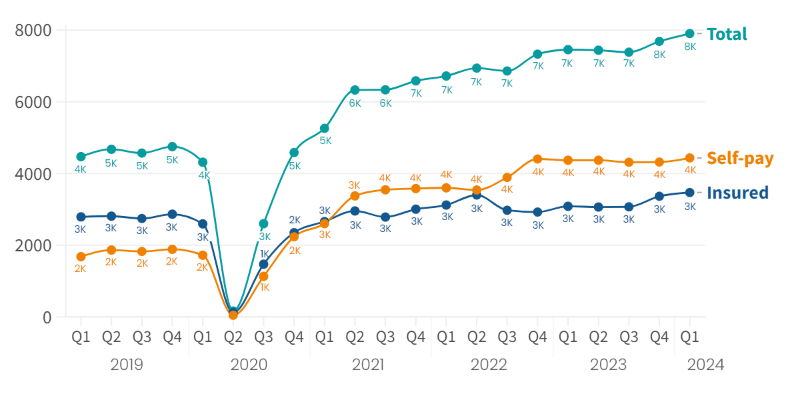
Q1 2024 in Wales at a glance
- There were over 7,900 reported private in-patient/day-care admissions in Wales, the highest ever quarterly total.
- Wales is the only UK nation where self-pay – where patients fund their own treatment from their savings, a loan or fundraising – is the dominant payment method.
- Self-pay admissions were at their highest level yet.
- The use of private medical insurance (PMI) was also at record levels.
Record independent healthcare in-patient admissions in Wales in Q1 2024
There were 7,900 reported admissions in Q1 2024, a 6% increase on the equivalent quarter in 2023, and a 3% increase from the previous highest quarter (Q4 2023).
There has been an increase in reported admissions in four of the past six quarters in Wales.
Admission change by volume in Wales (Q1 2023 v Q1 2024)
.png)
Private medical insurance admissions continue to grow as self-pay remains steady
Insured admissions
When comparing Q1 2024 to Q1 2023, the number of admissions funded by private medical insurance were up by 13% in Wales. There was also a 2% increase on the previous highest quarter (Q2 2022).
Admissions paid for with insurance have increased in four of the last five quarters, but they remain 13% below the highest pre-pandemic levels.
Pre-pandemic 60% of private admissions in Wales were funded by insurance. In Q1 2024 that had dropped to just 44%. This suggest a big change in patient behaviour, or different types of patient using private healthcare in Wales, since the pandemic.
Self-pay admissions
Self-pay admissions in Wales have remained fairly consistent over the past six quarters, but reached their highest ever level in Q1 2024.
Insured and Self-pay change % (Q1 2023 v Q1 2024) (based on non-rounded figures)
%20(Q1%202023%20v%20Q1%202024).png)
Admissions (rounded) in Wales by payment method (Q1 2023 v Q1 2024)

Top 10 procedures (Q1 2023 v Q1 2024)
@2x.png)
There was an increase in reported admissions in six of the top 10 procedures by volume when comparing Q1 2023 and Q1 2024.
‘Cataract surgery’ had the biggest increase by volume (375) and percentage (21%) of procedures.
‘Hip replacement (primary)’ had the biggest decrease by volume (25) and ‘Bladder examination’ had the biggest percentage decrease (13%).
Active consultants in private healthcare
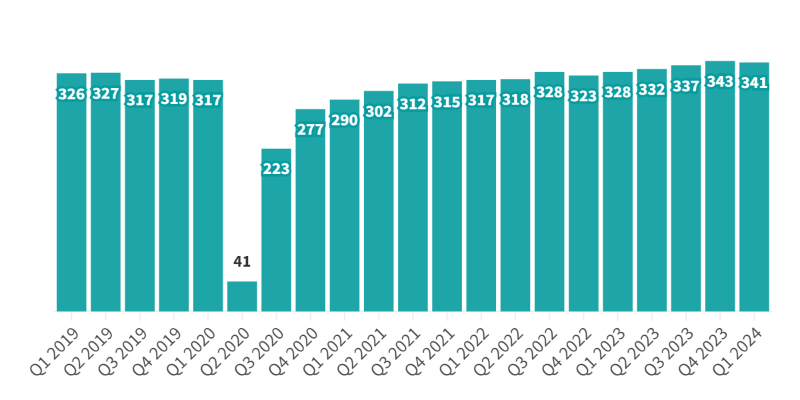
The number of consultants active in private healthcare regularly fluctuates, but remained high in Wales in Q1 2024, the second highest level since the pandemic and fourth highest since PHIN began collecting data. The number of active consultants in Q1 2024 was 4% higher than Q1 2023.
Quarterly comparison of active consultants for the top 10 PHIN specialties (Q1 2023 v Q1 2024)
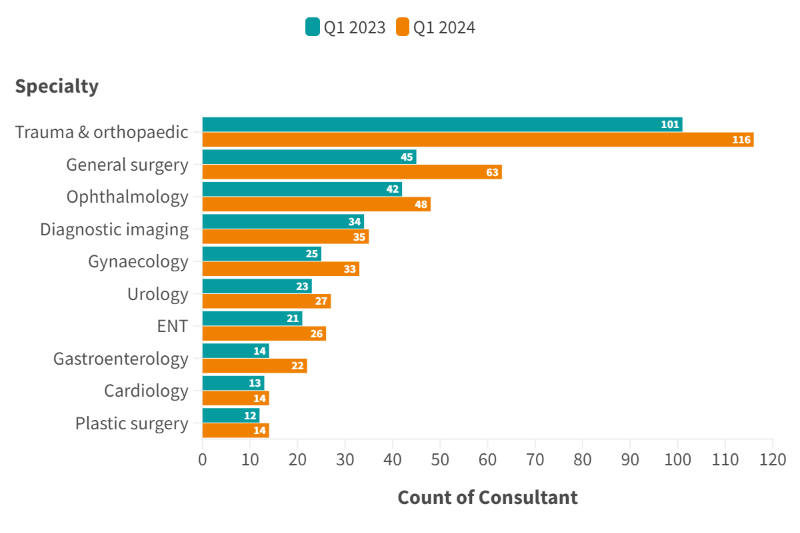
There was an increase in the number of active consultants across all Top 10 specialties in Wales with the largest increase by volume (+18) and percentage (+40%) being in ‘General surgery’.
Patient demographics
Volume of admissions by sex and payment method (Q1 2023 v Q1 2024)
There was an increased number of insured and self-pay admissions for both sexes compared to the same quarter in 2023.
Insured admissions for females both grew by 13%, and for males by 12%. Despite this there were more males using insurance than females with is the reverse of the situation in every other UK nation.
Self-pay admissions increase for females (7%), but reduced for males (-6%). In this case there were already more female admissions funded with this payment method.
Purchaser type and sex (Q1 2023 v Q1 2024)

Change in volume of admissions by age
There was an increase in admissions in all age groups from Q1 2023 to Q1 2024. The largest increase by volume was in the 60-69 age-group (160). The 20-29 age group had the second biggest increase by percentage (15%).
The 50-59 age-group, which is traditionally the highest user of private healthcare across the UK had the joint lowest percentage increase (1%).
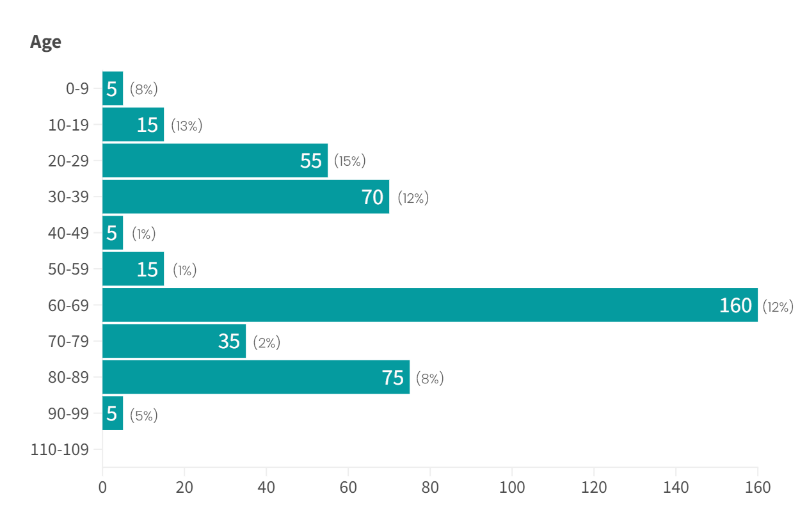
Important notes
All data described above taken from PHIN’s unique, national private dataset describing discharge activity (day case and inpatient). This excludes activity outside of PHIN’s mandate from the Competition and Markets Authority, such as outpatient diagnostics and mental health.
There is a time lag between collecting, validating and processing the data we receive from hospitals before we can publish it. This can be up to 6 months after treatment has been completed, to ensure a fair process and accurate data.
Activity numbers have been rounded to the nearest 5, with percentage based on the unrounded figures.
